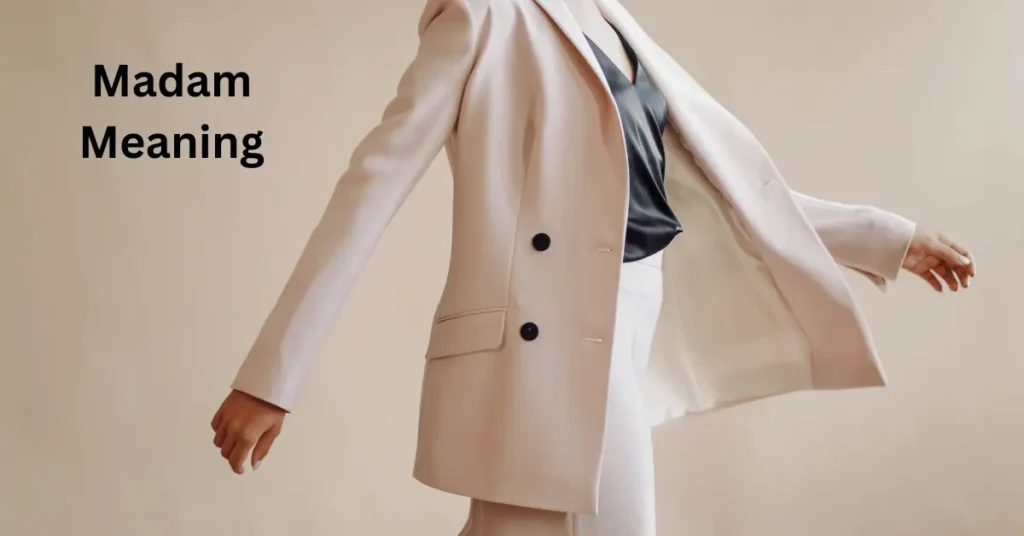Madam Meaning

Have you ever wondered about the word “madam meaning“? It’s a term we hear from time to time, often used to address women in formal settings.
But what does “madam” really mean, and where does it come from? In this post, we’re going to explore the meaning of “madam,” its history, and how it’s used today.
Whether you’re curious about its origins or just want to understand when to use it, we’ve got you covered! So, let’s dive in and take a closer look at this respectful and timeless word.
What Does “Madam” Mean?
The word “madam” is a formal and respectful way of addressing a woman, typically one who holds a position of authority, rank, or respect.
It’s often used to convey politeness and deference in a variety of situations, whether in professional environments, customer service, or even in everyday conversation.
At its core, “madam” signifies a woman of dignity, high status, or influence. It’s a term that acknowledges the woman’s standing in a social, professional, or even hierarchical context.
It’s akin to calling someone “sir” when addressing a man in a respectful way—both convey politeness and respect.
Here are some common ways “madam” is used:
As a form of address: “Madam” is often used in formal situations where you may not know a woman’s name, but still want to speak to her with respect.
For instance, in customer service, you might hear phrases like “How can I assist you, madam?” This usage acknowledges her presence in a respectful manner.
In professional or hierarchical contexts: In business or formal settings, “madam” is used to address a woman in a higher position of authority, such as a manager, leader, or senior executive.
It’s also a common term in diplomatic or legal settings, where politeness and proper titles matter.
In historical and aristocratic contexts: Historically, “madam” was used to refer to women of noble birth or those with elevated social status. It was a way of showing respect for their rank.
While “madam” can seem old-fashioned to some, it is still widely used today in many parts of the world.
It’s often seen in situations that require a more formal tone, such as in addressing a woman at a restaurant, in a hotel, or in any setting where professionalism and respect are paramount.
In a nutshell, “madam” isn’t just a word—it’s a term that conveys respect, acknowledges a woman’s status, and is used in both formal and polite contexts.
Definition of “Madam”
The word madam is a formal and respectful term used to address a woman, often one of higher rank, authority, or social standing.
It is used to convey politeness, deference, or respect in various situations, particularly in professional, social, or formal contexts.
While “madam” historically referred to women of noble or aristocratic status, it has evolved over time and is now a more general term used to show respect for a woman, regardless of her social position.
Key points of “madam”:
It signifies respect for a woman.
Often used in formal or professional settings.
Sometimes used in specific contexts like addressing a woman of authority or in customer service.
The female equivalent of “sir” (which is used to address a man respectfully).
Examples of “Madam” in Sentences:
In a formal address or greeting
“Good morning, madam. How can I assist you today?”
Here, “madam” is used to politely address a woman, often in a customer service situation. It’s respectful and formal.
In a professional context
“Madam President, may I present the next agenda item?”
In this example, “madam” is used as a title for a woman in a position of authority, in this case, the president of an organization or country.
In everyday formal conversation
“Excuse me, madam, could you please direct me to the nearest restroom?”
A polite way of addressing a woman when you don’t know her name but still want to show respect in a formal or polite manner.
Historical context
“Madam de Pompadour was a prominent figure at the court of King Louis XV.”
Here, “madam” is used as part of a noble title, referencing a woman of high rank in French history.
In literature or fiction
“Madam Bovary, the title character of Gustave Flaubert’s novel, reflects the struggles of a woman in 19th-century France.”
In this case, “madam” is used as a formal address, even though it’s part of a literary title.
In customer service or hospitality
“Your table is ready, madam. Please follow me.”
In restaurants or hotels, “madam” is commonly used to address female guests in a courteous and formal manner.
Key Points to Remember
- Politeness and Respect: “Madam” is used to show respect, particularly when addressing someone you don’t know well, or someone in a position of authority.
- Formal Usage: It’s most commonly used in professional, legal, diplomatic, and customer service settings.
- Widely Understood: While it might feel formal or old-fashioned to some, it’s still a widely accepted and respectful term for addressing women, especially in formal situations.
Word Origin of “Madam”

The word “madam” has an interesting and rich linguistic history, tracing its roots back to Old French and beyond. Let’s break it down:
Old French Origins
The word “madam” comes from the Old French word “ma dame,” which literally means “my lady.”
In this context, “dame” referred to a woman of high social standing, often someone who held noble or aristocratic rank.
The phrase “ma dame” was used as a respectful way to refer to a woman in such positions.
Over time, this term evolved and was shortened to simply “madam,” which became a formal way of addressing women of respect, whether or not they were of noble birth.
“Ma” is the Old French word for “my.”
“Dame” means “lady” or “woman of rank.”
Latin Influence
The word “dame” in Old French, which eventually became “madam,” is also derived from the Latin word “domina.”
The Latin term “domina” referred to a female ruler or mistress of the house, and it was the feminine form of “dominus,” meaning “lord” or “master.”
This reflects the historical connection between the term and women who held authority in their households or communities.
“Domina” in Latin signifies a woman of power or a female head of a household, further underscoring the connection between the modern meaning of “madam” and women in positions of authority.
Middle English Usage
The term began appearing in Middle English texts in the late 14th and early 15th centuries, borrowing from the Old French “ma dame.”
By this time, “madam” was already being used to address women of nobility or those in higher social classes, as well as to show respect in formal situations.
Evolution into Modern English
By the 16th century, “madam” had become fully integrated into the English language, used widely to address women in a polite, respectful, and formal manner.
Over time, its usage expanded beyond just women of high rank and came to apply more broadly to any woman in a formal or respectful context.
Though initially used primarily for women in positions of power or nobility, “madam” eventually became a more common term of polite address for women in general, though still maintaining its association with respect and authority.
Cultural and Social Impact
The use of “madam” remained largely formal for centuries. It was closely associated with professional, social, and aristocratic circles.
However, by the 18th and 19th centuries, the term began appearing in different contexts, even in certain industries.
For example, it was used to refer to the female head of a brothel, or in other cases, a woman in charge of a social establishment. Despite these variations, the word “madam” continued to convey respect in a wide range of settings.
The term “madam” comes from the Old French “ma dame” (my lady), which was used as a polite address for women of high rank.
It is rooted in the Latin word “domina,” meaning a woman of authority or ruler.
The word evolved through Middle English and has been used in the English language for centuries as a respectful and formal way to address women.
FAQs
What is the meaning of “madam”?
The term “madam” is a formal and respectful way to address a woman, typically one of higher rank or authority. It is often used in polite or professional settings and signifies respect. “Madam” can also be used as a general term to address any woman in a formal context, even if her rank or status is not specified.
Is “madam” the same as “ma’am”?
While both “madam” and “ma’am” are used as polite forms of address for women, there are slight differences:
“Madam” is more formal and is used in professional or formal settings, such as when addressing someone of higher rank or in business contexts.
“Ma’am” is a more casual version and is often used in everyday situations, especially in the United States.
Can “madam” be used to address anyone?
Although “madam” is typically used to address women with authority, respect, or in formal situations, it can also be used to address any woman in a polite and formal manner. It is most often used when the woman’s name or title is unknown, or when you want to convey a respectful tone.
Where did the word “madam” come from?
The word “madam” originates from the Old French phrase “ma dame,” which means “my lady.” It later evolved into the term “madam” in Middle English, retaining its meaning of a respectful and formal address for women. The word is also related to the Latin word “domina,” which means a female ruler or mistress of a household.
Is “madam” still used today?
Yes, “madam” is still used today in various contexts, especially in formal settings such as business, diplomacy, and customer service. While it may seem old-fashioned in some situations, it remains a widely accepted and polite form of address for women, particularly in professional or respectful conversations.
Conclusion
In conclusion, the word “madam” is a formal and respectful way to address a woman, often used in professional, polite, or formal situations.
It has its roots in Old French and Latin, originally referring to women of high rank or authority. Today, “madam” is still widely used to show respect, whether addressing a woman of authority or simply offering politeness in a conversation.
While it may feel old-fashioned in some contexts, it remains an important and meaningful term that reflects respect and courtesy.
Extra Points on “Madam”
- Cultural Differences: The use of “madam” can vary depending on the culture. In some countries, it’s very common to address any woman politely as “madam,” even if she’s not of high rank. In other places, it’s mainly reserved for women in positions of authority or respect.
- Madam in Popular Culture: The term “madam” is often used in movies, books, and TV shows to describe women in charge of a brothel or similar business. While this usage might seem negative, it’s important to remember that “madam” originally meant a woman of authority, and over time, the term was used in different contexts.
- Madam vs. Lady: While both “madam” and “lady” can be used to refer to women, “madam” tends to be more formal. “Lady” is often used to describe a woman with elegance or grace, but “madam” is more about showing respect, especially in a formal setting.
- The Role of “Madam” in Customer Service: In industries like hospitality, restaurants, and retail, “madam” is still frequently used to address female customers or clients. It’s a polite way of making sure the customer feels respected and valued, especially when their name isn’t known.
- Old-Fashioned but Still Useful: Although the word “madam” might sound old-fashioned to some, it remains a useful and respectful term in situations that require a more formal approach. Whether you’re addressing a woman in a professional setting or simply want to be polite, “madam” is still widely recognized and appreciated.